
PREV ARTICLE
NEXT ARTICLE
FULL ISSUE
PREV FULL ISSUE
GOLDBERG'S OFFERS RARE JUDAEAN MATERIALHere's the press release for an important group of Judaean and related coins in the upcoming Goldberg’s sale. -Editor Extremely Rare Judaean and Judaean-Related Roman Coins Featured in Goldberg’s New York Sale Once every few years, an auction of Judaean material of the highest caliber is held, and this will be the case when the combined Palm Desert Collection and the collection of Shlomo Moussaieff consisting of over 150 extremely rare Judaean and Judaean- related Roman Coins will be auctioned in the New York Sale held by Goldbergs Auction from January 8-10. The catalog and prices will serve as a guidebook to the popular field of Biblical Numismatics for many years. Goldberg’s New York Sale catalog can be obtained by calling (310) 551-2646; it is regularly priced at $25, but mention that you read about it in E-Sylum and pay only $15 in U.S. or $20 overseas. The catalog will soon be on view at www.goldbergcoins.com. 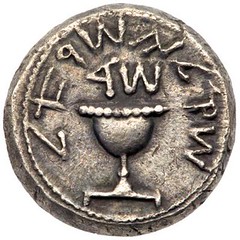  Auctioneer Ira Goldberg indicates that this may be the first auction to ever feature two extremely rare Year 4 shekels, one of which is shown above.  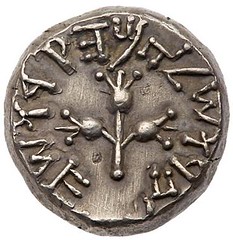 This superb Year 5 shekel would be the prize of any ancient Judaean collection. The Shoshana specimen sold for nearly $90,000 in 2012. Shekels form the heart of any ancient Judaean coin collection, and there is a remarkable group in the Palm Desert Collection, including one or more half shekels from Year 1, 2 and 3 of the First Revolt (66-70 CE) and for the first time ever in one sale—two extremely rare shekels produced in Year 4 plus the ultimate rarity--a Year 5 shekel; each of these is Extremely Fine or better. The coins of the Second Revolt (132- 135 CE) are also rich in rarities. Highlighting about a half dozen selas (tetradrachms) is a Year 1 with the Hebrew inscription “JERUSALEM†surrounding the Temple; a Year 2 with the under-coin of Galba clearly visible, including the Emperor’s profile and parts of the inscription; and a Year 3 with the enigmatic wavy line above the Temple. Plus a nice selection of bronzes and zuzim (denarii). 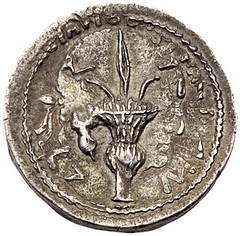 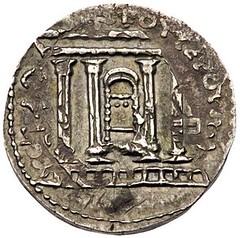 This sela, dated in Year Two (133/134 CE) of the Second Revolt, was struck over a tetradrachm issued by the Roman Emperor Galba, who reigned briefly for seven months from 68 to 69 CE (while the First Revolt was still in full swing!). His right-facing profile is clear above (left). While virtually all of the silver coins produced by the Jews during the Second Revolt were struck over Roman coins, it must have given the minter great satisfaction to strike over this coin, in particular, produced by the enemy of the Jews during their previous revolt against Rome. In addition to rare shekels, half shekels, selas and zuzim of the First Revolt (66-70 CE) and Second Revolt (132-135 CE), the Palm Desert Collection in Goldberg’s New York Sale, collectors will be especially interested in a modest number of extremely rare Judaean-related Roman coins. These coins are less often encountered at dealers and auctions because they are never found in quantity in hoards. Judaean coins were buried at the time of these wars for safekeeping, but there was never any reason for Romans to bury Judaean-related coins. The earliest Judaean-related Roman coin is an extremely fine tetradrachm, with superb portraits of Cleopatra and her lover Mark Antony, that was issued in Akko. The most comprehensive and well known Judaean-related Roman coin series is “Judaea Capta,†consisting of bronze, silver and gold coins celebrating the Roman victory over Judaea in 70 CE. The vast majority of these coins carry the inscription JUDAEA CAPTA, JUDAEA AUGUST or JUDAEA, however some of the rarer varieties do not—including some of the coins in the Goldberg sale: a Vespasian sestertius with the hybrid inscription JUDAEA AUGUST, a Vespasian aureus inscribed DE JUDAEIS, minted at Lugdunum, c. 72 CE, and another aureus of Vespasian depicting two Jewish captives before triumphant Roman soldiers, horses, etc., with TRIUMP AUG in exergue. 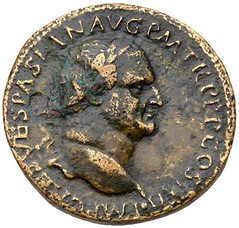 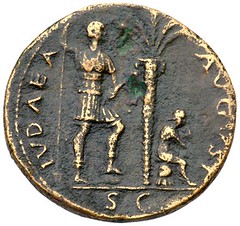 Judaea Capta type sestertii generally have the inscription IVDAEA CAPTA or VICTORIA AUGUSTI, but this extremely rare hybrid features the strange legend IVDAEA AUGUST. 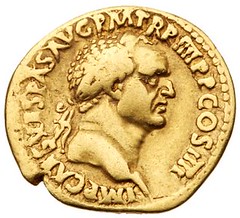  Very rare Judaea Capta type gold aureus features a Roman trophy with the inscription DE IVDAEIS, minted at Lugdunum (modern Lyon, France). The singularly important Judaean-related Roman coin issued in between the two Jewish revolts against Rome features the Emperor Nerva (96-98 CE) and a palm tree surrounded by the inscription FISCI JUDAICI CALUMNIA SUBLATA (the abuses of the Jewish Tax are ended) and SC (Senatus Consulto = by consent of the Senate).  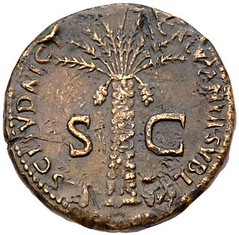 Nerva’s enigmatic inscription FISCI JUDAICI CALUMNIA SUBLATA on this sestertius offered in the Palm Desert Collection has inspired numerous articles attempting to explain its meaning. The event that might have ignited the Second Revolt (132-135 CE), the visit of Hadrian to Jerusalem in 131 CE—where he stated his plans to convert the Jewish Temple to a Roman one—is commemorated on two very rare bronze coins in the Goldberg Sale. On the first coin, a sestertius, Hadrian is greeted by a female (representing the Roman province of Judaea) who hands the Emperor a dove, and he in turn is offering her an olive branch of peace, with three small Jewish figures in the background, surrounded by the inscription ADVENTU AUG JUDAEA and S.C. in exergue. The second coin, an “as†denomination, commemorates the same event but is even rarer as a type and denomination; it features Hadrian with an arm outstretched to a kneeling female representation of Judaea, and three small Jews (one carrying olive branch) in the background; the inscription is JUDAEA in exergue. 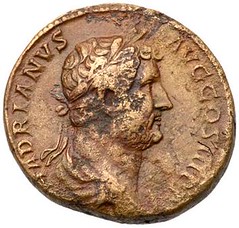  Hadrian’s ADVENTU AUG JUDAEA coin is a virtually unknown “as†denomination. Note that the name sestertius means "two and one half," referring to its nominal value of two and a half asses. Beginners and advanced collectors of Biblical Coins will find lots ranging from small bronze leptons issued by Roman Prefects and Procurators of Judaea, estimated at under $100 each, to an extremely rare Year 5 (70 CE) shekel of the First Revolt, that is expected to bring somewhere in the high five-figures. Wayne Homren, Editor The Numismatic Bibliomania Society is a non-profit organization promoting numismatic literature. See our web site at coinbooks.org. To submit items for publication in The E-Sylum, write to the Editor at this address: whomren@gmail.com To subscribe go to: https://my.binhost.com/lists/listinfo/esylum All Rights Reserved. NBS Home Page Contact the NBS webmaster 
|